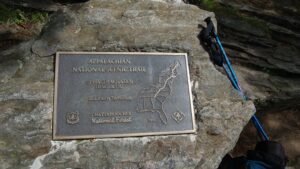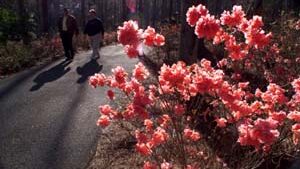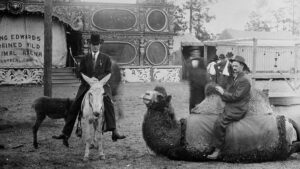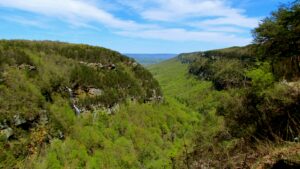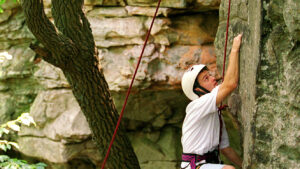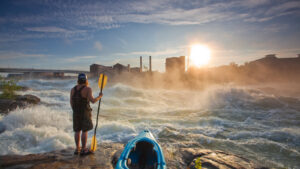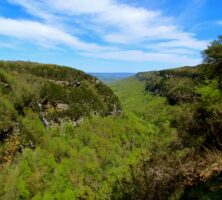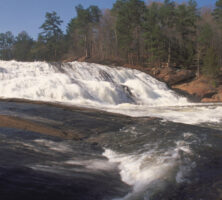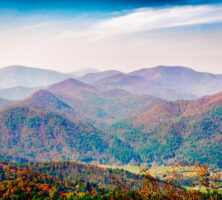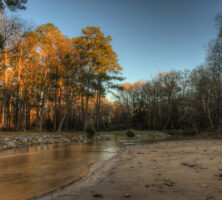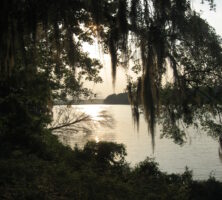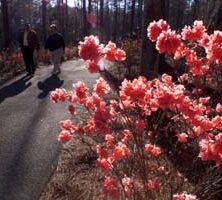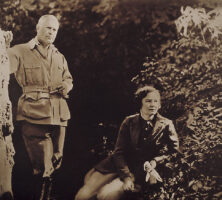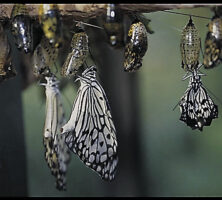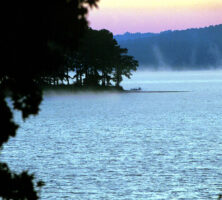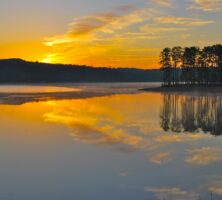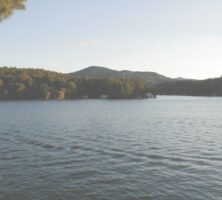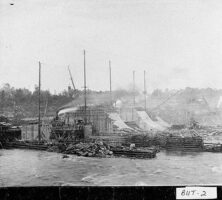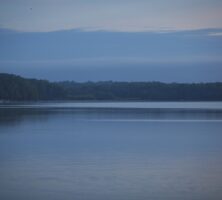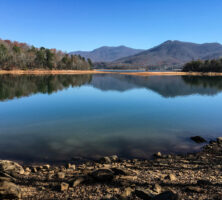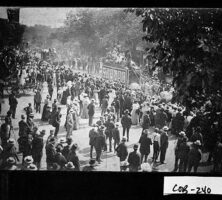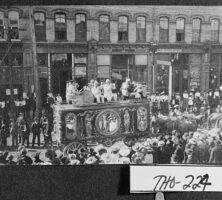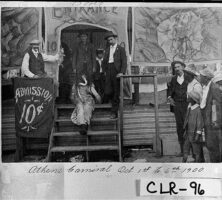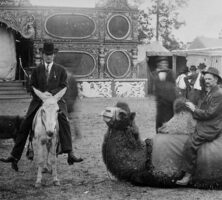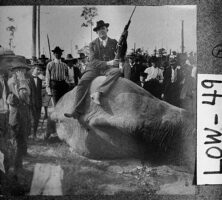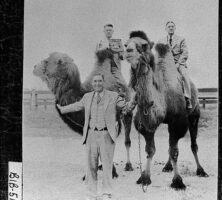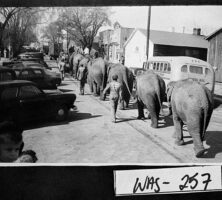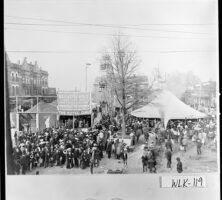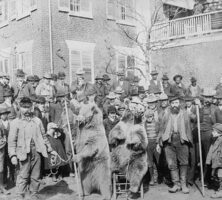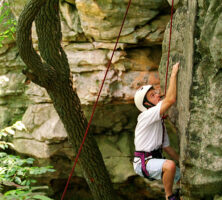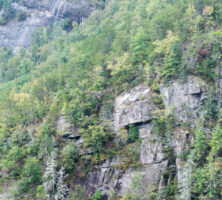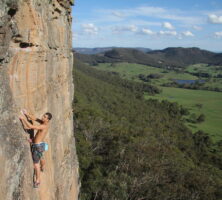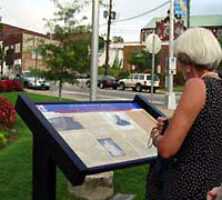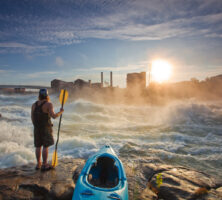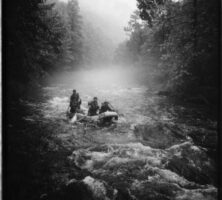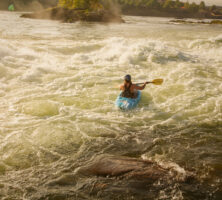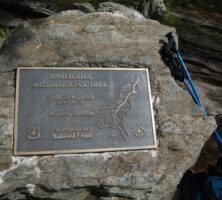The New Georgia Encyclopedia is supported by funding from A More Perfect Union, a special initiative of the National Endowment for the Humanities.
Radium Springs, one of Georgia's Seven Natural Wonders, was the site of a casino that had its heyday during the 1920s. The casino was demolished in 2003.
Courtesy of Georgia Archives, Vanishing Georgia, #
dgh004.
The New Georgia Encyclopedia does not hold the copyright for this media resource and can neither grant nor deny permission to republish or reproduce the image online or in print. Requests for permission to publish or reproduce the resource should be submitted to the Georgia Archives.
Radium Springs is a natural cold-water spring located in the eponymously named community of Radium Springs in Dougherty County. It is one of Georgia’s largest natural springs, pumping up to 70,000 gallons of water a minute in ideal conditions. Its waters stay at an average temperature of sixty-eight degrees Fahrenheit year-round and contain naturally occurring trace amounts of radium
From U.S. Geological Survey
The New Georgia Encyclopedia does not hold the copyright for this media resource and can neither grant nor deny permission to republish or reproduce the image online or in print. All requests for permission to publish or reproduce the resource must be submitted to the rights holder.
Cloudland Canyon State Park is located in Dade County, near the northern end of Lookout Mountain, in the Appalachian Plateau.
Photograph by Jeff Gunn
The New Georgia Encyclopedia does not hold the copyright for this media resource and can neither grant nor deny permission to republish or reproduce the image online or in print. All requests for permission to publish or reproduce the resource must be submitted to the rights holder.
High Falls State Park, near Jackson in Butts County, is a popular destination along the Towaliga River for camping and boating. The town of High Falls, established in the early 1800s, became a ghost town during the 1880s, when the railroads gained prominence over waterways for commercial transportation.
Courtesy of Georgia Department of Economic Development.
The New Georgia Encyclopedia does not hold the copyright for this media resource and can neither grant nor deny permission to republish or reproduce the image online or in print. Requests for permission to publish or reproduce the resource may need to be submitted to the Georgia Department of Economic Development.
Black Rock Mountain State Park in the Blue Ridge Mountains is located in Rabun County along the Eastern Continental Divide. At an altitude of 3,640 feet, Black Rock Mountain is the highest state park in Georgia and offers numerous scenic overlooks and hiking trails.
Image from Bradley Huchteman
The New Georgia Encyclopedia does not hold the copyright for this media resource and can neither grant nor deny permission to republish or reproduce the image online or in print. All requests for permission to publish or reproduce the resource must be submitted to the rights holder.
Indian Springs State Park, located in Butts County, is one of the first two state parks to be established in Georgia. In 1927 the state passed a resolution to preserve the Indian Springs Reserve, and in 1931 the park was founded as part of the newly created Georgia State Parks System.
Image by David Dugan
The New Georgia Encyclopedia does not hold the copyright for this media resource and can neither grant nor deny permission to republish or reproduce the image online or in print. All requests for permission to publish or reproduce the resource must be submitted to the rights holder.
The F. D. Roosevelt State Park, located on Pine Mountain in Harris County, was named for U.S. president Franklin D. Roosevelt, who maintained a home in nearby Warm Springs. The park was established under Roosevelt's New Deal policies in the mid-1930s.
Courtesy of Explore Georgia, Photograph by Ralph Daniel.
The New Georgia Encyclopedia does not hold the copyright for this media resource and can neither grant nor deny permission to republish or reproduce the image online or in print. Requests for permission to publish or reproduce the resource may need to be submitted to Explore Georgia.
The Georgia Veterans Memorial State Park in Cordele County was established in honor of U.S. veterans. The park offers a museum featuring wartime memoribilia, as well as a lodge, conference center, and golf course.
Image from Courtney McGough
The New Georgia Encyclopedia does not hold the copyright for this media resource and can neither grant nor deny permission to republish or reproduce the image online or in print. All requests for permission to publish or reproduce the resource must be submitted to the rights holder.
The New Georgia Encyclopedia does not hold the copyright for this media resource and can neither grant nor deny permission to republish or reproduce the image online or in print. All requests for permission to publish or reproduce the resource must be submitted to the rights holder.
The fifty-six-room lodge at Amicalola Falls State Park in Dawson County was built during the 1980s. The park's primary attraction is the 729-foot Amicalola Falls, the highest waterfall in Georgia.
Image from J. Stephen Conn
The New Georgia Encyclopedia does not hold the copyright for this media resource and can neither grant nor deny permission to republish or reproduce the image online or in print. All requests for permission to publish or reproduce the resource must be submitted to the rights holder.
Vogel State Park was established in 1931 as one of the first two state parks in Georgia. Located at the base of Blood Mountain in Union County, Vogel offers scenic mountain trails and close proximity to Brasstown Bald, the highest point in the state.
Courtesy of Explore Georgia, Photograph by Ralph Daniel.
The New Georgia Encyclopedia does not hold the copyright for this media resource and can neither grant nor deny permission to republish or reproduce the image online or in print. Requests for permission to publish or reproduce the resource may need to be submitted to Explore Georgia.
The New Georgia Encyclopedia does not hold the copyright for this media resource and can neither grant nor deny permission to republish or reproduce the image online or in print. All requests for permission to publish or reproduce the resource must be submitted to the rights holder.
A Columbia azalea blooms along a walking path in the Callaway Brothers Azalea Bowl at Callaway Gardens in Pine Mountain. Dedicated in 1999, the Azalea Bowl is the world's largest azalea garden.
Courtesy of Atlanta Journal-Constitution.
The New Georgia Encyclopedia does not hold the copyright for this media resource and can neither grant nor deny permission to republish or reproduce the image online or in print. All requests for permission to publish or reproduce the resource must be submitted to the Atlanta Journal-Constitution.
In 1930 Cason and Virginia Callaway purchased 2,500 acres of land in Harris County upon which a number of indigenous flowering plants, including the plumleaf azalea, grew. The couple developed the land, and in 1952 they opened the Ida Cason Gardens (later Callaway Gardens) to the public.
Courtesy of Callaway Gardens
The New Georgia Encyclopedia does not hold the copyright for this media resource and can neither grant nor deny permission to republish or reproduce the image online or in print. All requests for permission to publish or reproduce the resource must be submitted to the rights holder.
The New Georgia Encyclopedia does not hold the copyright for this media resource and can neither grant nor deny permission to republish or reproduce the image online or in print. All requests for permission to publish or reproduce the resource must be submitted to the rights holder.
Japanese paperkites emerge from their cocoons in the conservatory of the Cecil B. Day Butterfly Center at Callaway Gardens. The center is the largest enclosed tropical conservatory in North America and is home to more than 1,000 butterflies.
Courtesy of Callaway Gardens
The New Georgia Encyclopedia does not hold the copyright for this media resource and can neither grant nor deny permission to republish or reproduce the image online or in print. All requests for permission to publish or reproduce the resource must be submitted to the rights holder.
A popular boating destination, West Point Lake in Troup County is formed by an impoundment of the Chattahoochee River. The lake covers 25,900 acres in area and has a shoreline of 525 miles.
Courtesy of U.S. Army Corps of Engineers
The New Georgia Encyclopedia does not hold the copyright for this media resource and can neither grant nor deny permission to republish or reproduce the image online or in print. All requests for permission to publish or reproduce the resource must be submitted to the rights holder.
Lake Allatoona was created in 1950 by the U.S. Army Corps of Engineers for flood control. At more than 12,000 acres, Allatoona is one of the larger lakes in the state.
Image from Ronnie
The New Georgia Encyclopedia does not hold the copyright for this media resource and can neither grant nor deny permission to republish or reproduce the image online or in print. All requests for permission to publish or reproduce the resource must be submitted to the rights holder.
Lake Rabun was created in 1915 by the Georgia Power Company. Today, residents enjoy water sports, such as jet-skiing, at the Rabun County lake.
Photograph from Wikimedia Commons
The New Georgia Encyclopedia does not hold the copyright for this media resource and can neither grant nor deny permission to republish or reproduce the image online or in print. All requests for permission to publish or reproduce the resource must be submitted to the rights holder.
The New Georgia Encyclopedia does not hold the copyright for this media resource and can neither grant nor deny permission to republish or reproduce the image online or in print. All requests for permission to publish or reproduce the resource must be submitted to the rights holder.
Dam construction, ca. 1909, on the Ocmulgee River near Jackson, in Butts County.
Courtesy of Georgia Archives, Vanishing Georgia, #
but002.
The New Georgia Encyclopedia does not hold the copyright for this media resource and can neither grant nor deny permission to republish or reproduce the image online or in print. Requests for permission to publish or reproduce the resource should be submitted to the Georgia Archives.
The New Georgia Encyclopedia does not hold the copyright for this media resource and can neither grant nor deny permission to republish or reproduce the image online or in print. All requests for permission to publish or reproduce the resource must be submitted to the rights holder.
The Georgia Power Company built Lake Oconee in 1979. The area around the lake includes a golf course and a resort.
Courtesy of Explore Georgia, Photograph by Ralph Daniel.
The New Georgia Encyclopedia does not hold the copyright for this media resource and can neither grant nor deny permission to republish or reproduce the image online or in print. Requests for permission to publish or reproduce the resource may need to be submitted to Explore Georgia.
The New Georgia Encyclopedia does not hold the copyright for this media resource and can neither grant nor deny permission to republish or reproduce the image online or in print. All requests for permission to publish or reproduce the resource must be submitted to the rights holder.
Lake Chatuge, in the north Georgia mountains, was created by the Tennessee Valley Authority during World War II.
Image from Shawn Taylor
The New Georgia Encyclopedia does not hold the copyright for this media resource and can neither grant nor deny permission to republish or reproduce the image online or in print. All requests for permission to publish or reproduce the resource must be submitted to the rights holder.
Lake Hartwell, named after Revolutionary War hero Nancy Hart, provides drinking water, hydropower, and public entertainment to millions of people each year. The reservoir, which borders Georgia and South Carolina, exists because of Hartwell Dam on the Savannah River.
Courtesy of UGA Archway Partnership
The New Georgia Encyclopedia does not hold the copyright for this media resource and can neither grant nor deny permission to republish or reproduce the image online or in print. All requests for permission to publish or reproduce the resource must be submitted to the rights holder.
Circus parade in Marietta, circa 1910. The parade through the town was designed to generate excitement in those who were wavering about attending the circus, and it usually did. Here, a band is playing atop the circus wagon drawn by white horses.
Courtesy of Georgia Archives, Vanishing Georgia, #
cob240.
The New Georgia Encyclopedia does not hold the copyright for this media resource and can neither grant nor deny permission to republish or reproduce the image online or in print. Requests for permission to publish or reproduce the resource should be submitted to the Georgia Archives.
Circus wagons and animals participate in a parade along Patterson Street in Valdosta, October 29, 1899. The parade was part of the festivities associated with the Georgia State Fair, held in Valdosta.
Courtesy of Georgia Archives, Vanishing Georgia, #
low048.
The New Georgia Encyclopedia does not hold the copyright for this media resource and can neither grant nor deny permission to republish or reproduce the image online or in print. Requests for permission to publish or reproduce the resource should be submitted to the Georgia Archives.
The Ringling Brothers Circus band playing atop their circus wagon in a parade through the downtown area of Thomasville in 1904.
Courtesy of Georgia Archives, Vanishing Georgia, #
tho224.
The New Georgia Encyclopedia does not hold the copyright for this media resource and can neither grant nor deny permission to republish or reproduce the image online or in print. Requests for permission to publish or reproduce the resource should be submitted to the Georgia Archives.
Carnivals usually drew large crowds, and none of the attractions were more popular than the freak show. There one could gaze upon fire breathers, sword swallowers, two-headed calves, and human pincushions. This woman with a live snake in her mouth was photographed at a carnival in Athens in October 1900. The price to view the show was 10 cents.
Courtesy of Georgia Archives, Vanishing Georgia, #
clr096.
The New Georgia Encyclopedia does not hold the copyright for this media resource and can neither grant nor deny permission to republish or reproduce the image online or in print. Requests for permission to publish or reproduce the resource should be submitted to the Georgia Archives.
A circus parades through the square in downtown Madison, circa 1912. This photograph is included in the Vanishing Georgia collection at the Georgia Archives in Morrow. The project was initiated by Carroll Hart, the former director of the archives, in 1975 to collect and preserve images documenting the state's past.
Courtesy of Georgia Archives, Vanishing Georgia, #
mor017-014.
The New Georgia Encyclopedia does not hold the copyright for this media resource and can neither grant nor deny permission to republish or reproduce the image online or in print. Requests for permission to publish or reproduce the resource should be submitted to the Georgia Archives.
Men astride a burro and a camel from the King Edwards Trained Wild Animal Arena, on Sea Island in the early 1900s. The King Edwards troupe was from Montreal, Canada.
Courtesy of Georgia Archives, Vanishing Georgia, # gly250.
The New Georgia Encyclopedia does not hold the copyright for this media resource and can neither grant nor deny permission to republish or reproduce the image online or in print. Requests for permission to publish or reproduce the resource should be submitted to the Georgia Archives.
Children and adults line up to gain admission to the Hoxie Brothers Circus, which had come to Waynesboro, circa 1968.
Courtesy of Georgia Archives, Vanishing Georgia, #
bur114.
The New Georgia Encyclopedia does not hold the copyright for this media resource and can neither grant nor deny permission to republish or reproduce the image online or in print. Requests for permission to publish or reproduce the resource should be submitted to the Georgia Archives.
When Gypsy, a circus elephant, trampled her keeper to death on November 22, 1902, and went on a wild rampage through the streets of Valdosta, Chief of Police Calvin Dampier and a posse of citizens spent part of one night tracking the enraged animal. The following day Dampier brought the elephant down with a shot from his rifle. Here he poses atop the dead elephant.
Courtesy of Georgia Archives, Vanishing Georgia, #
low049.
The New Georgia Encyclopedia does not hold the copyright for this media resource and can neither grant nor deny permission to republish or reproduce the image online or in print. Requests for permission to publish or reproduce the resource should be submitted to the Georgia Archives.
In the early 1930s the circus wintered in Macon at Central City Park. Roy Neal is standing in front of the two camels. Walter Johnson is reading a copy of , a magazine of the period. Wilmer Shepherd is astride the camel at right.
Courtesy of Georgia Archives, Vanishing Georgia, #
bib051.
The New Georgia Encyclopedia does not hold the copyright for this media resource and can neither grant nor deny permission to republish or reproduce the image online or in print. Requests for permission to publish or reproduce the resource should be submitted to the Georgia Archives.
Elephants seen on West Haynes Street in Sandersville were part of a King Brothers Christian Circus parade in the 1950s.
Courtesy of Georgia Archives, Vanishing Georgia, #
was257.
The New Georgia Encyclopedia does not hold the copyright for this media resource and can neither grant nor deny permission to republish or reproduce the image online or in print. Requests for permission to publish or reproduce the resource should be submitted to the Georgia Archives.
A carnival on the square in Washington is pictured circa 1901. The Fitzpatrick Hotel is on the left, and the old Wilkes County Courthouse is visible behind the Ferris wheel. A sign advertises "wild Aztec girls," and says they are "twenty-four years old, stand three feet tall, weigh thirty-seven pounds, and their heads are no larger than an orange."
Courtesy of Georgia Archives, Vanishing Georgia, #
wlk119.
The New Georgia Encyclopedia does not hold the copyright for this media resource and can neither grant nor deny permission to republish or reproduce the image online or in print. Requests for permission to publish or reproduce the resource should be submitted to the Georgia Archives.
Three Frenchmen brought a couple of dancing bears to Dahlonega for a show in 1892.
Courtesy of Georgia Archives, Vanishing Georgia, # lum058.
The New Georgia Encyclopedia does not hold the copyright for this media resource and can neither grant nor deny permission to republish or reproduce the image online or in print. Requests for permission to publish or reproduce the resource should be submitted to the Georgia Archives.
Terry Gates searches for his next handhold while climbing a seventy-foot wall at Pigeon Mountain near LaFayette.
Courtesy of Atlanta Journal-Constitution.
The New Georgia Encyclopedia does not hold the copyright for this media resource and can neither grant nor deny permission to republish or reproduce the image online or in print. All requests for permission to publish or reproduce the resource must be submitted to the Atlanta Journal-Constitution.
The New Georgia Encyclopedia does not hold the copyright for this media resource and can neither grant nor deny permission to republish or reproduce the image online or in print. All requests for permission to publish or reproduce the resource must be submitted to the rights holder.
Some of the most difficult rock climbing in the state can be found at Tallulah Gorge State Park in Rabun County.
Image from D Wright
The New Georgia Encyclopedia does not hold the copyright for this media resource and can neither grant nor deny permission to republish or reproduce the image online or in print. All requests for permission to publish or reproduce the resource must be submitted to the rights holder.
Rock climbing at Lookout Mountain in Walker County, part of the Appalachian Plateau in Georgia.
Image from Adam Kubalica
The New Georgia Encyclopedia does not hold the copyright for this media resource and can neither grant nor deny permission to republish or reproduce the image online or in print. All requests for permission to publish or reproduce the resource must be submitted to the rights holder.
A visitor to Macon City Hall studies an interpretive marker created by Georgia Civil War Heritage Trails. The marker recounts the building's history and commemorates its use as Georgia's temporary state capitol building during the last months of the Civil War.
Photograph by Linda Woodward Geiger
The New Georgia Encyclopedia does not hold the copyright for this media resource and can neither grant nor deny permission to republish or reproduce the image online or in print. All requests for permission to publish or reproduce the resource must be submitted to the rights holder.
Whitewater paddling can be a dangerous sport. Georgia law requires that lifejackets be worn on rivers in the state. Helmets, although not required on all rivers, are also necessary for safety.
Courtesy of Georgia Department of Economic Development.
The New Georgia Encyclopedia does not hold the copyright for this media resource and can neither grant nor deny permission to republish or reproduce the image online or in print. Requests for permission to publish or reproduce the resource may need to be submitted to the Georgia Department of Economic Development.
Paddlers raft down the Chattooga River in Rabun County.
Courtesy of UGA Cooperative Extension Service. Photograph by James D. Strawser
The New Georgia Encyclopedia does not hold the copyright for this media resource and can neither grant nor deny permission to republish or reproduce the image online or in print. All requests for permission to publish or reproduce the resource must be submitted to the rights holder.
Whitewater enthusiasts have discovered that Georgia, blessed with a multitude of navigable rivers, abundant rainfall, and marked changes in elevation, is in many ways a whitewater paradise.
Courtesy of Georgia Department of Economic Development.
The New Georgia Encyclopedia does not hold the copyright for this media resource and can neither grant nor deny permission to republish or reproduce the image online or in print. Requests for permission to publish or reproduce the resource may need to be submitted to the Georgia Department of Economic Development.
Made primarily with reinforced rubber and plastic, rafts are ideally suited for whitewater paddling. The resiliency of the materials used in their construction allows the rafts to withstand powerful impacts with rocks and emerge unscathed.
Courtesy of Georgia Department of Economic Development.
The New Georgia Encyclopedia does not hold the copyright for this media resource and can neither grant nor deny permission to republish or reproduce the image online or in print. Requests for permission to publish or reproduce the resource may need to be submitted to the Georgia Department of Economic Development.
The New Georgia Encyclopedia does not hold the copyright for this media resource and can neither grant nor deny permission to republish or reproduce the image online or in print. All requests for permission to publish or reproduce the resource must be submitted to the rights holder.
A plaque marks the southern end of the Appalachian Trail near the peak of Springer Mountain.
Photograph from JR P.
The New Georgia Encyclopedia does not hold the copyright for this media resource and can neither grant nor deny permission to republish or reproduce the image online or in print. All requests for permission to publish or reproduce the resource must be submitted to the rights holder.
